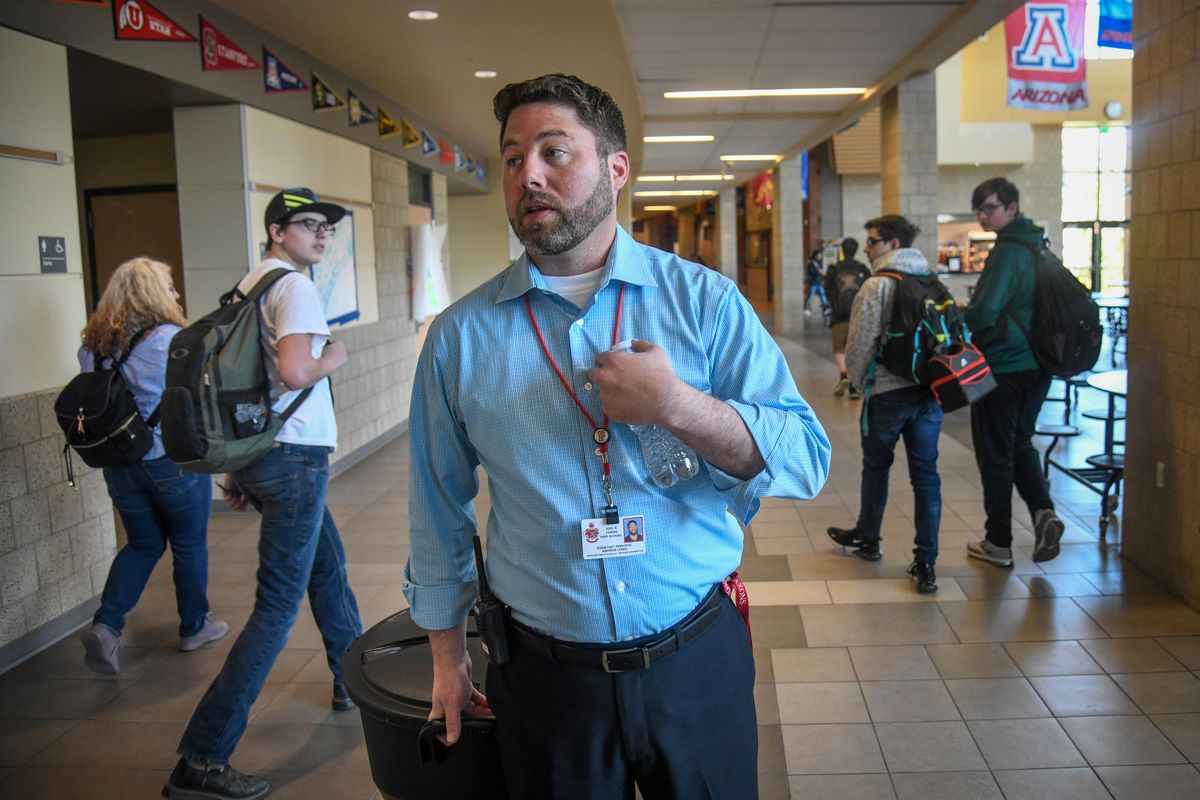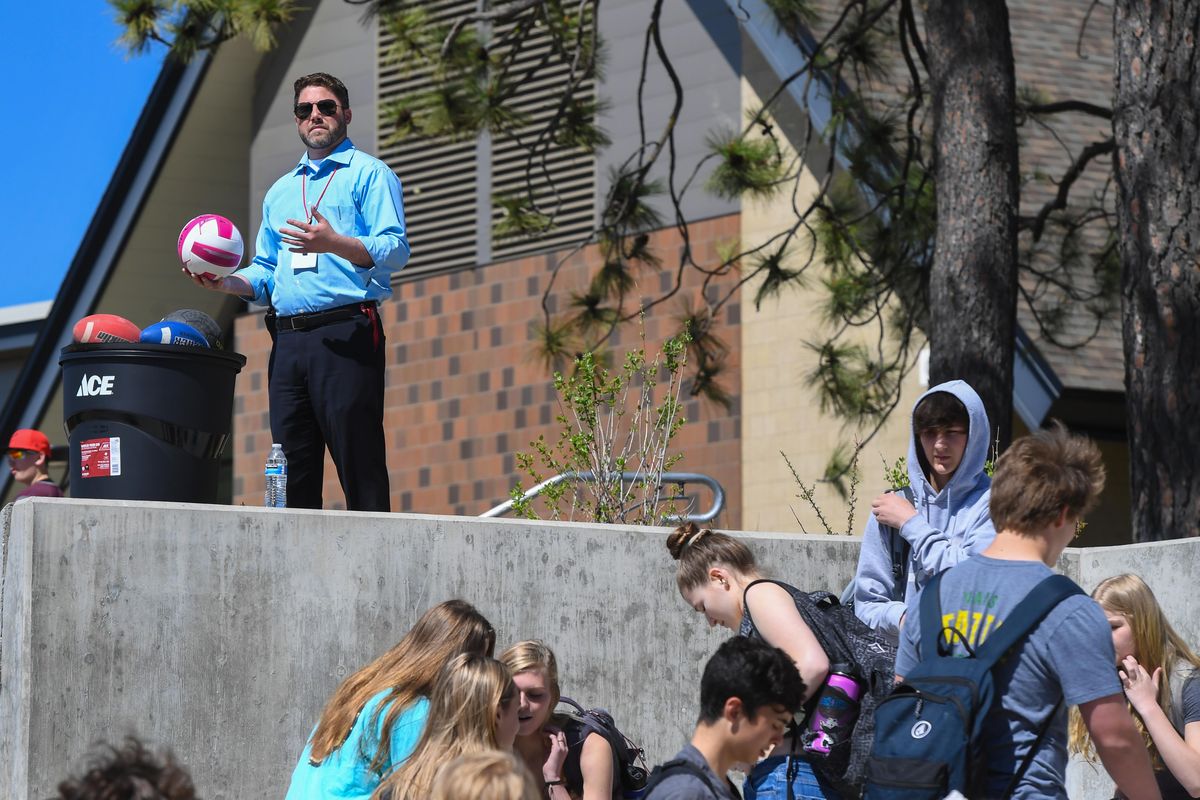Welcome to the modern high school: Professionals take on spike in teen challenges
Ferris High School Assistant Principal Andrew Lewis walks down the hallway at the start of the first lunch period, Wednesday, May 8, 2019, in Spokane, Wash. (Dan Pelle / The Spokesman-Review)Buy a print of this photo
In the hallways of Ferris High School, the fires are easy to spot.
They’re the embers that keep Assistant Principal Andrew Lewis awake at night.
They are the teens whose smoldering anger is constantly stoked by poverty, drugs, dysfunctional parents and cyberbullying in the middle of the night.
“There’s no doubt this job is harder,” Lewis said. “But there’s also no doubt that it’s harder to be a teenager these days.”
Lewis sees them every day in what is one of the most challenging and misunderstood jobs in the public school system: assistant principal.
In Spokane and elsewhere, there are more assistant principals than ever. Ferris has three, plus two “principal assistants” – a convenient target for critics who see administrative bloat around every corner, especially during the current budget crisis in Spokane Public Schools.
In Spokane, high school assistant principals make $110,000 or more. Middle and elementary school assistants make slightly less.
Lewis has a nice office. It’s air-conditioned and modern and appropriate for a middle manager with a master’s degree.
But he doesn’t spend much time there.
On a recent morning, most of Lewis’ time was spent in the hallways and outside the building.
His goal was to get acquainted with all 1,800 students at Ferris, which is home to “a lot of troubled kids who haven’t made themselves known and are in desperate need,” Lewis said.
That need has grown, in Spokane and especially at Ferris, where 10 years ago 19% of students came from families poor enough that they qualified for free and reduced-price school lunches.
Today, about 42% of students qualify. While that’s still better than most high schools, it is surprisingly high to those who think of the South Hill school as affluent.
“The demographics have really changed,” Principal Ken Schutz said as he watched the lunchroom scene on a recent morning.
Schutz blames societal changes, including a shrinking middle class.
“For whatever reason, a lot more people are living in poverty,” Schutz said. “And I’ve never seen so many mental health issues.
“Many of them were hidden, and counseling takes a lot of critical time,” Schutz said. “It takes days and weeks to figure it out and give them the right resources, and we have to get through the paperwork to get them to those resources.”
A glance through the 1974 edition of the Ferris yearbook, the Exeter, shows a similar enrollment, and 84 teachers. Today, faculty staffing is about the same, 95, but everything else has changed.
In 1974, Ferris had one principal, two assistant principals, seven secretaries and four counselors, one for each class.
Today, Schutz’s office includes five assistant principals and 11 secretaries.
The roster of counselors has grown to 14, only four of whom fill traditional roles. Two others are mental health specialists and one is a psychologist; others deal with chemical dependency and behavior issues.
Ferris also employs 28 paraeducators, a job description that didn’t exist in 1974. These employees assist teachers, supervise students outside the classroom and provide other support for teachers.
The student population has not changed much: The Ferris student body has hovered around 1,700 to 1,800 students for decades.
The safety net is cast even wider at Rogers High School, which has 200 fewer students than Ferris but employs 11 learning support teachers, who focus on offering supplementary teaching to students requiring additional help. Rogers also has 19 paraeducators.
Administrators say such growing needs cost more money.
Nationally, non-teacher staff positions grew 47% from 1992 to 2015, while overall enrollment grew by only 20%.
In 1994, the Spokane school district had a $177 million budget. Had its budget growth matched the national cost of living, the district’s budget would have grown to about $302 million next year. Instead, the budget has ballooned to $455 million.
Such growth has less to do with teacher salaries than the growth in the number of positions at Ferris and other schools.
Those extra hands are kept busy by every sort of crisis, most of which are created by dysfunction at home.
Just as Schutz sees a shrinking middle class, administrators are seeing fewer middle-range parents.
Instead they are dealing with high-needs parents at both ends of the socioeconomic spectrum.
Every day, phone calls and email messages pour into the Ferris office over every conceivable complaint: grades, discipline and even questions about why their child isn’t getting a chance to start in the big game.
Schutz, an administrator for 25 years, recalls that “when I first started, when you called home, people just agreed with you and assumed you had the best interests of the child in mind.”
“Now, with almost every decision we make, there’s a conversation about whether that happened or this happened. Parents have become more questioning, and they usually question every decision you make.”
Often, they go to the top. Parents who believe their daughter deserved an A instead of a B don’t go to the teacher; they take their case straight to the principal, he said.
Some athletes’ parents are prone to bypass the coach, the athletic director and even Schutz; they take their case downtown, where it usually gets sent back to the coach.
“Every parent wants the best for their kid,” Schutz said. “They all love their kids, and we do too, but sometimes it takes a lot of time.”
Discipline issues take even more time since the district embraced Restorative Practices. The program has received national praise for lessening tensions and repairing relationships, but requires heavy involvement from administrators, counselors and others.
“We have to get through the paperwork to get them to those resources,” Schutz said. “It takes time.”
It also requires patience.
“We work in an environment where almost every interaction is negative in some way,” Lewis said. “We’re in that weird line between raising kids, honoring teachers, partnering with families and trying to find wins for all of them.”
As Lewis sat in his office, three underclassmen walked up to his door and said they were worried about a classmate.
Lewis asked a few appropriate questions, then ordered them back to class – another fine line he straddles every day.
“If you cut the conversations off too soon, you send the message that you don’t want to help,” Lewis said.
The big crises come without warning.
At Ferris, every administrator carries a radio. When Lewis’ goes off, it’s often accompanied by a message to come to a classroom.
When that happens, Lewis drops everything and runs toward the unknown. Sometimes it’s a fight, and it’s up to Lewis to end it.
“But the last thing you want to do is step into the fight,” Lewis said. “Often we have to get physical with kids, but we want to do it in a loving, protective way,” generally with aid from a campus resource officer or another administrator.
That’s not always the case, however. During an alercation in January, resource officer Shawn Audie resigned after he was accused of using excessive force.
Help rarely comes from other students, who these days seem more interested in filming the altercation and posting the action on social media as quickly as possible.
Schutz, Lewis and other administrators agree that social media has changed the landscape of school – even before the school day begins.
Not that long ago, bullying happened in the halls. Now it begins at 2 a.m. with the buzzing of cellphones.
“When the school day ends, everything seems OK,” said Rogers Principal Lori Wyborney. “Then somebody breaks up … what happened at midnight follows them back to school.”
Lewis is waiting for them. While fellow assistant principals Lisa Henderson and Kelly Kight spend most of their time with academic issues, Lewis deals primarily with the duties of the traditional vice principal.
“Parents have a lot of trust in giving their kids to us every day,” Lewis said. “There is a balance, we want to do everything we can, but we can’t do everything.
“Some of these kids need just one adult who can make a difference in their lives.”

